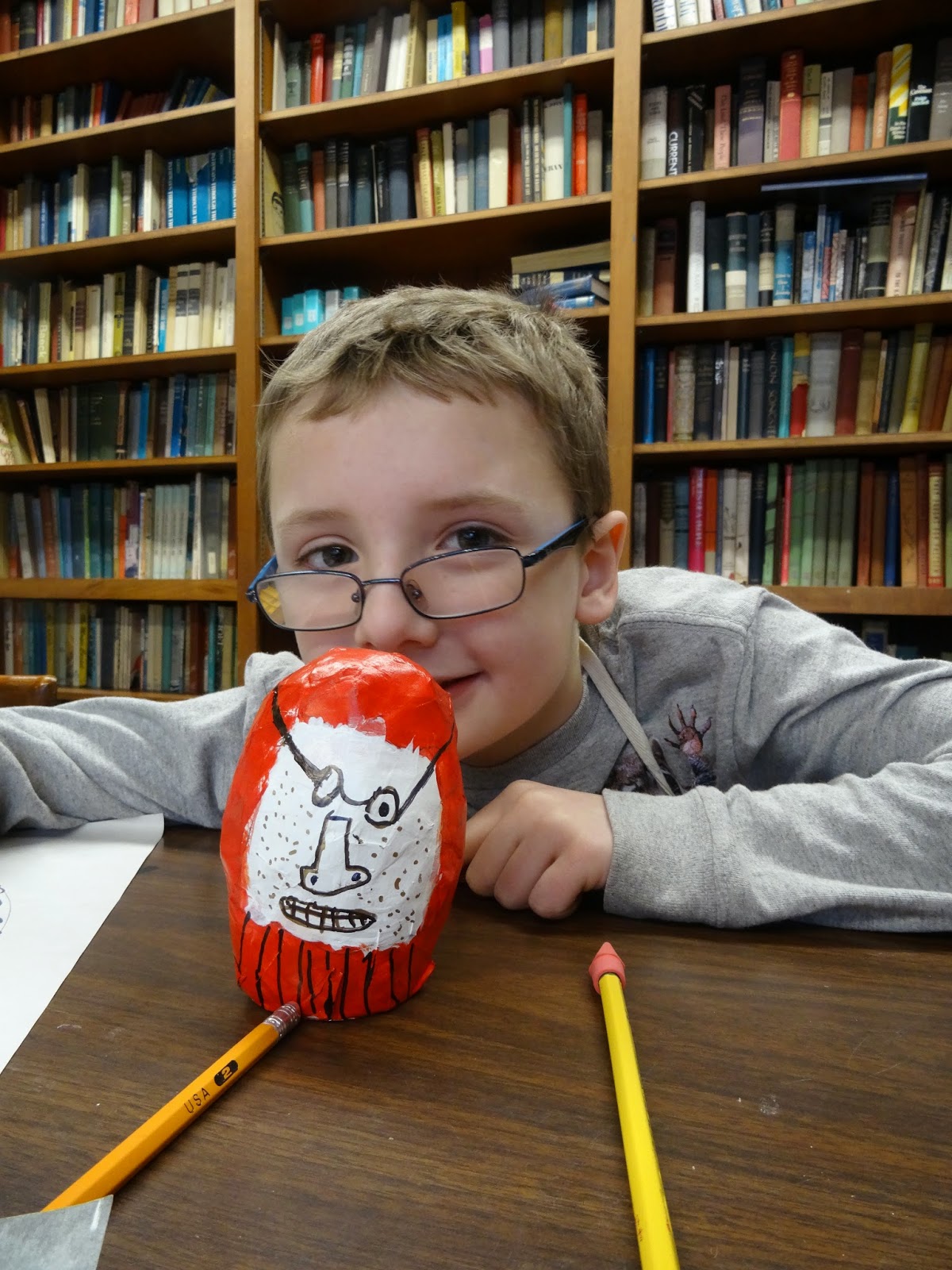When a globally inspired art project has a fabulously entertaining legend, it is sure to be a hit with your students. The Daruma is a such a project. (An authentic Daruma is pictured above, along with a pic of of my 2nd grade student and his Daruma.) The Daruma is a Japanese toy, based upon the legend of Bodhidharma, a 5th century monk from India who is often credited with introducing Zen Buddhism. The following is an abbreviated version of a marvelous legend about this monk, that relates to the Daruma.
It is said that Bodhidharma while in China, sat in a meditative state, staring at a cave wall for 9 years without moving. He struggled to stay awake and alert during this extended meditation, and in a fit of frustration, he cut off his eyelids to keep from dozing. He threw them in the dirt, and the first tea plants sprung up at the place where his eyelids fell. From then on, tea was used to resist sleepiness and aid in meditation. At the end of 9 years of meditation, Bodhidharma's arms and legs had atrophied or withered away, and consequently he lost all use of them. He rolled his way to spread his teachings.
The Daruma toy, with bulging, lidless eyes, represents Bodhidarma. It has a rounded body and weighted bottom, so that no matter what, it always returns to a standing position, symbolizing Bodidharma's positive attitude and self-discipline. The toy is purchased with blank eyes. The owner paints in the pupil of one eye upon making a wish or beginning a project. When the wish comes true or the project is complete, the other pupil is painted. Politicians use Darumas for good luck in elections, painting one eye when they begin pursuing a political office, and painting the other one when they have won the election.
In the past, my students have made their own Daruma beginning with a plastic Easter egg, weighted with some plasticine clay pressed into the bottom and then covered in papier-mache. Since I only had three students in my DragonWing Arts class this winter, I hoped that my students could build a slightly bigger version; unfortunately plastic eggs were not available yet when we began. I experimented with other options, and we ended up using the bottom halves of bowling pins from a kiddie bowling set. We sealed the bottom with a cardboard circle and some tape, poured plaster of Paris in to weigh them, and when the plaster had hardened we sealed the top with some cardboard and newspaper before covering with papier-mache.
But when complete, my students were disappointed that while weighted, the bottoms were not rounded like that of my sample (not pictured), and didn't self-right as easily as we expected.
By this time, Easter eggs were in the stores, and I gave them the opportunity to make a second Daruma. We didn't have a lot of time, since making a second Daruma was an unplanned project, but they all happily jumped in. You can see the egg-shaped ones, with a coat of papier-mache and some white paint on the faces, in the photo below.
While the traditional Daruma color is red, I let the kids select the color they wanted to use. We had NO time to spare; it was their last class for winter session
We blew the paint dry with a hair dryer and the faces were drawn on with black and gold Sharpies. Below is one Daruma pair, bowling pin on the left, Easter egg on the right; the artist is a second grader.
And here's another pair, not yet finished, by a 4th grader (she's got Sharpies at home, so I know she will complete it). They are Daruma twins, even with a matching lock of hair!
I don't seem to have a photo of the third student's pair, which is unfortunate, as he painted the egg Daruma gray, and decorated it to look like sort of a robot Daruma. Really adorable.
| I know there's other ways to build these cute little guys, but according to my students, the roly-poly bottom is essential. If you have a great idea how we could make large ones that have that characteristic, let me know. I did try to make one out of a balloon (even though I absolutely despise putting papier-mache on balloons), but weighting it was a problem, and with it being hollow with no strong structure inside, it required multiple layers of papier-mache and we didn't have the time to do that. But I'm interested in your ideas. Note: You can find previous posts on this blog, about making Darumas with my 6th grade students prior to my retirement, by clicking on the 'Darumas' label at the bottom of this post, or by typing the word 'Daruma' into the search bar on the right side of the blog. |














